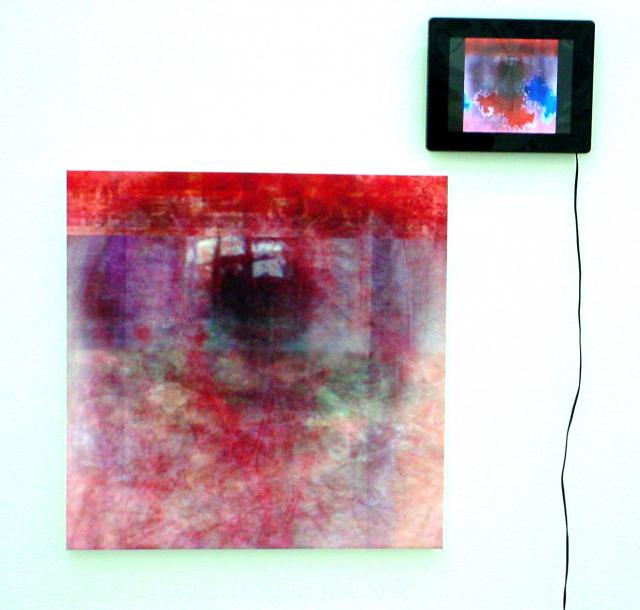
4 Questions from Galerie Richard about Art Rétinal Revisité: Histoire de l'Oeil
Galerie Richard 1. "Art Rétinal Revisité: Histoire de l'Oeil" - why did you choose this and not another title and theme for the exhibition? What message are you sending through this exhibition? And what is your ultimate goal with Art Rétinal Revisité?
Joseph Nechvatal: Clowns are rarely asked to explain their jokes and poets are never expected to explain their poems. Likewise I usually abhor these kinds of questions, but in this case I will attempt to oblige you.
Speaking most generally: the body of work brought together under the title Art Rétinal Revisité: Histoire de l'Oeil came into existence through a theoretical investigation into the role of noise in culture. This research adapted the audio noise understanding of noise music and applies it to visual art, architecture, and consciousness in a new book I have written entitled Immersion Into Noise (published by Open Humanities Press). A digital version of the book Immersion Into Noise is being included in the sale of the painting/animation assemblages that will be exhibited in this show.
The question I wish to put forth with this exhibition is: On a planet that is increasingly technologically linked and globally mediated, how might visual noises break and reconnect in distinctive and productive ways within practices located in the world of art and thought?
For many, if anything is representative of the art of today it is ambivalence. Ostensibly, everything today is permitted in art – and thus nothing is necessary. As a result, art and entertainment, it is said, have merged. Perhaps surprisingly, for me, the denial of this merger and the answer to the question posed above is to be found within the challenge of a noise style that strengthens unique personal powers of imagination and critical thinking through a beautiful self-perception. So in a way, this show is about looking at looking.
This approach was based on my observation that a noisy cultural constructivism is in the process of confronting unconnected ideal models of entertainment with information processing and self-re-organization through the digitalization of knowledge. I have tried to explore such questions through the connection between noise and violence and noise and the sacred.
Noise may break some connections, but connections will always continue to grow in other directions; creating new thoughts and new affects. The notion of noise as creation itself is thus an important one that needs to be reconsidered and reevaluated. The viral animations coupled with the canvases represent this function.
More specifically: Art Rétinal Revisité (Retinal Art Revisited) points quite obviously to Marcel Duchamp’s position that art that appeals to the intelligence (the mind) cannot as well appeal to the eye. I disagree with him here. Intelligent art need not be anti-retinal. Beautiful woman can be incredibly smart, as well.
Georges Bataille’s theories of excess are a key reference in my noise vision book sketched out above. That is why I honor his erotic fiction Histoire de l'Oeil (Story of the Eye) in the subtitle of the exhibition.
For Bataille, excess is the non-hypocritical human condition, which he took as being roused non-productive expenditure (excess) entangled with exhilaration. Excess is, for Bataille, not so much a surplus as an effective passage beyond established limits, an impulse which exceeds even its own threshold. Engaged sight works that way as well, as there is always something more to see.
Galerie Richard 2. The works you're planning to exhibit are quite diverse (the eye and the other image that remains ambiguous - are they lips? or a rectum?) - and what is the 'fil conducteur' between them? Why did you choose the lip/rectum images?
Joseph Nechvatal: Yes. The eyes are bracketed and centered by paintings-animations that investigate the lips of the human rectum. I recognized that the eye was the highest placed input valve on the human desiring-machine – and the rectum the lowest. And I wanted to even them out. I wanted to give them equal value. Both are controlled by psychic-influenced sphincters.
Galerie Richard 3. How do these works "revisit retinal art" to quote the title?
Joseph Nechvatal: They call to mind and make fun of Marcel Duchamp’s prejudice that smart art cannot also be beautiful to the eye.
Galerie Richard 4. For the September exhibition you have chosen to create a video for each painting and exhibit them together. This is a rather new approach. Could you explain how you came to this decision?
Joseph Nechvatal: Yes. I paired a large painting with a large projection of the computer virus project eating the same image that is on the painting first in 2004 at the Digital Sublime show at MOCA in Taipei. This is an application of my viractual position - a position that has been put forward in my book Towards an Immersive Intelligence: Essays on the Work of Art in the Age of Computer Technology and Virtual Reality that was published by Edgewise Press in New York in 2009.
Art Rétinal Revisité: Histoire de l'Oeil
September 4th - October 2nd 2010
http://www.galerierichard.com